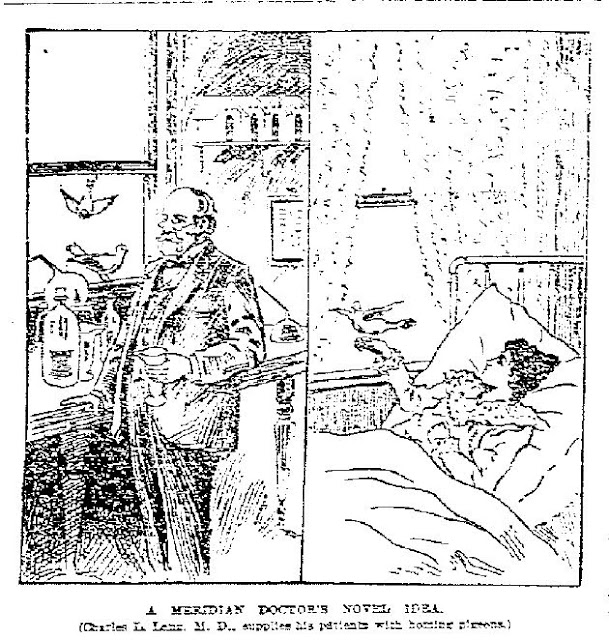Newspaper research has yielded two rather cute items:
To nervous people, Meridian is a mecca. The stillness startles strangers. Horace Wilson lost his voice after years of speaking in a whisper. An accident cannot happen there. The staid decorum of that sedate community has never been startled by seeing a man on a run since W. Smith Ingham moved away. They retire at sundown and rise any time from nine a.m. till noon; even the cream at the butter factory dare not rise until then, last summer. The post-office department should change the name to the hermitage.
“Local Briefs”
The Cato Citizen,
Saturday, January 11, 1896.
____________
Odd Pigeon Post
Homing Birds Used by a Meridian Doctor
Scheme is a Fine Success
[Most of the article is illegible, but below is some of it that I was able to decipher]
Dr. Charles E. Lang of Meridian. Cayuga County, N.Y., has now regularly established a carrier pigeon service between his patients and himself. Every physician who has a practice that takes him about the country districts to any great extent knows how hard it is to keep himself thoroughly posted as to the condition of far away patients. The city physician's clientele as a rule is more compactly located, there not being the opportunity for him to practice in so large a territory as his country brother. Now the country physician practices over an immense extent of territory, infinitely greater than nine out of ten of even his own patients think. He is quite likely to have two patients criticially ill, each patient twelve miles apart an each living a like distance from the doctor's home. Easily it will be seen that paying daily calls and keeping posted with sick persons scattered about like that become almost an impossibility.
These conditions confronted Doctor Lang for many years and he tried to find a way to help himself and benefit his patients. The homing pigeon solved the problem. In other words, the doctor is the producer, the pigeon is the middleman and the patient the consumer -- of medicine. In this particular instance, however, the middle man benefits both producer and consumer, a state of affairs as singular as Doctor Lang's project.
The Doctor has found time to keep up on medical topics, take good care of his patients and cultivate pigeons, all three very successfully. It is the success that has made life easier for him, more tranquil for his patients and a source of amusement and interest to every stranger who hears what is going on. The Doctor says his plan is a thorough success and he recommends brother practictioners to try it.
How the scheme works.
There is nothing difficult about it all. In the first place the Doctor keeps in mind constantly the patients whose condition he is anxious to be thoroughly posted upon. Then he sends to each of these one or more carrier pigeons, according to the severity of the case and the necessity of frequent communication. The nurse, or some member of the family of the person who is ill has blanks which the Doctor has left, and these must be filled in with a detailed record of time, pulse, temperature and respiration. A blank filled, it is inclosed [sic] in an aluminum capsule, made to clasp on the leg. This done, the bird is released and at once speeds away to the home of the waiting physician, and at the rate of a mile a minute. In this connection it is well to remember that while to the uninitiated the words "carrier pigeon" include all pigeons that carry messages, in reality they do not mean that. The homing pigeon is the carrier pigeon trained to normal, sollid, hard work.
[long illegible section]
There is another way of looking at the plan of Doctor Lang. It helps the pocket. Naturally, when a physician can save a third of his time he surely has a third more time to devote patients whom he could not otherwise visit. Therefore the homing pigeon is a money maker, an assistant physician, and a benefit to the world in general.
The Syracuse Sunday Herald,
March 21, 1897
12 February 2010
Subscribe to:
Posts (Atom)




